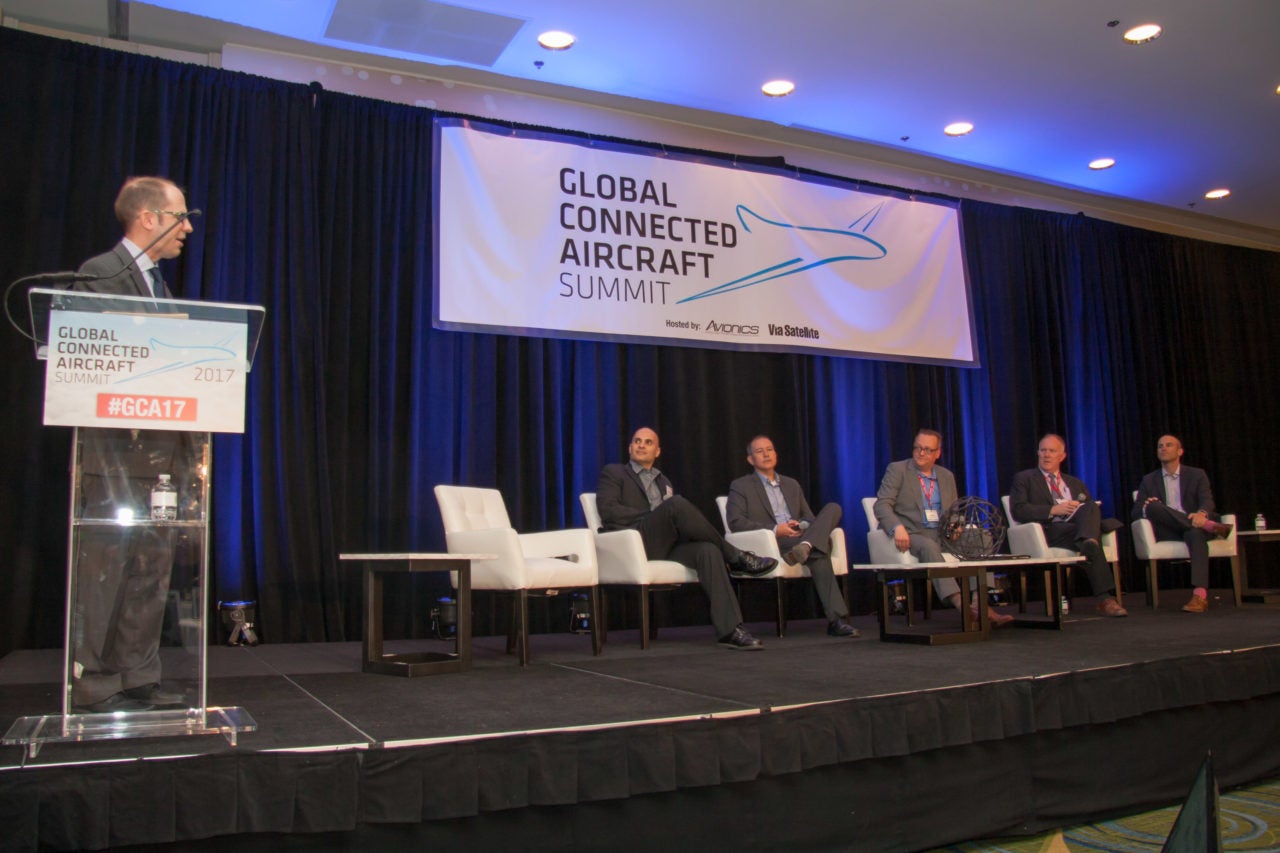Latest News

L-R: Meherwan Polad, Senior Director of Business Development, Commercial Mobile Systems, ViaSat; Jon Merritt, director of flight operations, CNS programs and cockpit technology, United Airlines; Jon Norris, Sr. Director, corporate sales & marketing, Panasonic Avionics; Mark Rich, VP, Connected Fleet, Airbus; David Bijur, Regional President, North America, Gogo. Photo: Vince Lim.
According to speakers at last week’s Global Connected Aircraft Summit in Washington, D.C., the airline industry has reached an inflection point in which connectivity is becoming a commodity, rather than just a luxury. During a conversation on the next generation of In-Flight Connectivity (IFC) services, panelists agreed that customer expectations have surpassed what many airlines are currently able to offer, and that businesses that wish to stay relevant will have to quickly improve the ways they exploit bandwidth.
“Here in the United States [connectivity] is an expectation. People fly on airplanes based on the fact there is Wi-Fi on the plane. No longer do everyday passengers expect to have a relaxing, unplugged two to four hour trip,” said Jon Merritt, director of flight operations, CNS programs and cockpit technology for United Airlines.
Jon Norris, senior director of corporate sales and marketing for Panasonic Avionics, spoke similarly, stating that it’s only a matter of time before the majority of Panasonic’s airline customers that have not yet introduced connectivity start to do so. “Even those that have been slow to the game are making a commitment to move forward. Over the next five to 10 years, every commercial aircraft is going to have IFC. It’s going to be a necessity for doing business,” he said.
And it isn’t just for the passenger experience. “We haven’t even touched the surface of the operational efficiency that can be generated through the use of IFC,” Norris added.
Hardware & Challenges
As Tara Bamburg, associate manager of product development for Southwest Airlines, pointed out in a panel on the passenger experience, one of the biggest challenges of keeping up with customer demand is equipage costs and revenue lost as a result of grounding planes for maintenance. “Connectivity is an added value and an expectation for our customers, but it’s not worth grounding a plane for multiple days,” she argued.
“Airlines care almost more than anything about having the airplane stay flying,” echoed David Bijur, North America regional president for Gogo. Consequently, he said, the industry should focus on implementing hardware that can be easily adapted for new services, or that can be cost-effectively swapped out. “When we think about the roadmap, particularly for the vendors, what we really need are Line-Replaceable Units (LRUs) that can withstand the test of time,” he said.
Mark Rich, vice president of connected fleet for Airbus, also suggested taking a more holistic approach to hardware: “Often reliability is improved through redundancy. But every time we add a new IFC capability it’s adding yet another system to our aircraft. Every new thing we add to our aircraft adds to the cost,” he said, “We’re looking at how can we go about creating much more integrated IFC solutions. Here, it’s not a stack of individual solutions but rather a collection of solutions that work together. Rather than rely upon one antenna how can we support multiple antennas?”
Future Landscape
Panelists expressed differences in opinion when it came to what connectivity might look like for airplanes in the future. Norris said that while he does believe airlines can significantly improve the experience from where it is today, he doesn’t foresee the aviation industry ever catching up with internet performance on the ground. “I think that’s an unrealistic goal to achieve,” he said.
However, Meherwan Polad, senior director of business development for commercial mobile systems at ViaSat, said that the only real limiting factor is the cost of bandwidth. “I’d like to challenge the notion we can’t do in the air what we do on the ground. We’re taking that same network and bringing it to the air. JetBlue is taking that and extending fully free internet to everybody,” he said. “When it comes to antennas and modems, we’re investing in those. Do they matter as much as bandwidth? No.”
Low-cost bandwidth also opens the door to countless operational benefits, Polad added. “Whether it’s streaming live engine data or tracking the number of paninis in your food trolley, all that stuff can go down live. There’s no need to skimp and save when you’ve got plentiful, low-cost bandwidth,” he said.
Still, the panelists agreed the future is hard to predict. No one can say exactly what new applications will explode in the near future, what new hardware will be necessary, or how customers will want to use connectivity. “Social media is really exploding today … but in the end, do we know what’s next? No,” Polad said “What can you do to prepare for that? The only thing you can do is have a lot of bandwidth. We don’t know what’s coming — all we know is it’s going to be bandwidth-intensive.”
Get the latest Via Satellite news!
Subscribe Now